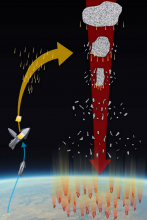Listen to today's episode of StarDate on the web the same day it airs in high-quality streaming audio without any extra ads or announcements. Choose a $8 one-month pass, or listen every day for a year for just $30.
You are here
More Moon and Mars
Mars is a world of extreme geology. It has the tallest mountain in the solar system, one of the longest canyons, and one of the biggest holes in the ground. That hole is about 1400 miles wide and up to five miles deep. And its floor has been sculpted by everything from blowing sand to flowing water.
Hellas basin is in the southern hemisphere. It’s surrounded by jumbled terrain that’s a good bit higher than the planet’s average elevation.
And that’s no coincidence. Hellas basin was created about four billion years ago, when a giant asteroid slammed into the Martian surface. It blasted out a huge amount of rock — enough to cover the 48 contiguous United States in a layer more than two miles thick. Some of that rock fell back onto the surface, forming some of the higher terrain around Hellas.
The crater’s floor has been molded by wind-blown sand, glaciers, and flowing water. There’s even some evidence that it once was filled with water, forming a large sea.
Because Hellas is so deep, it has the densest atmosphere of any spot on Mars — twice the global average. So under the right conditions, liquid water could exist on the surface there for short periods. And during winter, the basin fills with frost and clouds, making it look pure white — a cold hole in the surface of Mars.
Look for Mars leading the Moon across the sky late tonight. It looks like a bright orange star, and rises to the upper right of the Moon.
Script by Damond Benningfield






